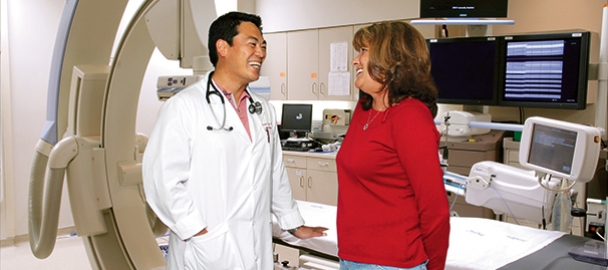
When Kim Hogerson became manager of emergency services at Saddleback Medical Center, she never dreamed that she would end up in the ER herself. But last March, the 56-year-old nurse found that her life depended on the very programs she had helped develop. Kim’s problems started during a strenuous hike. An avid exerciser, she was climbing a steep hill when she felt an odd twinge in her neck. By the time she reached the top, she couldn’t breathe. As she made her way home, drenched in sweat, lungs burning, she knew that something was seriously wrong.
“But I did a typical woman thing,” she says. “I figured if I put my feet up for a few minutes, I would be all right.” She wasn’t. A small piece of plaque had ruptured in an artery supplying blood to her heart, triggering a heart attack. Thirty minutes passed before she called 9-1-1.
The paramedics, one of whom had trained at Saddleback Medical Center, immediately alerted the hospital’s cardiac catheterization team. Before Kim arrived, they were mobilized to perform balloon angioplasty—a catheter-based procedure that opens blocked blood vessels without surgery. Kim’s doctor, cardiologist Ronald Gim, MD, says that timing is critical.
“Angioplasty should be performed within 90 minutes of the time a patient enters the doors of the emergency room,” says Dr. Gim. Called the “door-to-balloon” time, this time frame optimizes outcomes by reducing the amount of damage done to the heart muscle.
However, in Kim’s case, angioplasty was delayed when she went into full cardiac arrest in the ER. Without the slightest delay, the emergency room staff began working to restart her heart. Kim was resuscitated and taken to the cath lab where she underwent emergency angioplasty. A balloon-tipped catheter was threaded into the blocked artery through a small incision in her groin. Once the blood vessel was cleared of its life-threatening obstruction, it was propped open permanently with a tiny metal cage called a stent.
Despite the fact that angioplasty had been delayed when Kim went into full cardiac arrest, her “door-to-balloon” time was only 42 minutes—well below the rigorous 90-minute standard set forth by the American College of Cardiology and the American Heart Association.
“Nationwide, fewer than half of hospitals are able to meet this goal, which is one of the most important tangible measures of care for heart attack patients,” says Dr. Gim.
Three days after her heart attack, Kim left the hospital.
“I’m the poster child for how the system works at Saddleback Medical Center,” she says. “The paramedics, the cardiologists and the cath lab team— all pulled together to make sure I had angioplasty within the recommended time frame.” As a result, Kim experienced no damage to her heart. “The adage that ‘time is muscle’ is true,” says Dr. Gim. “Delays in treating a heart attack substantially increase the likelihood and amount of damage to the heart muscle.”
As a specialist in emergency care, Kim knows this is true and encourages people to call 9-1-1 if they suspect they’re having a heart attack.
“Women are especially likely to delay getting help for heart attacks—sometimes for hours or even days,” says Dr. Gim. “They worry about being a burden or don’t recognize the symptoms, which are often different from the symptoms men have.”
Today, Kim is exercising more than ever. She’s stopped smoking and is working to lower her cholesterol—two major risk factors for cardiovascular disease.
Of the heart attack she says, “I never thought I was going to die. I knew what a great system we have at Saddleback Medical Center and I trusted the Saddleback Medcial Center emergency and cardiac care teams completely. I knew they’d take good care of me.”